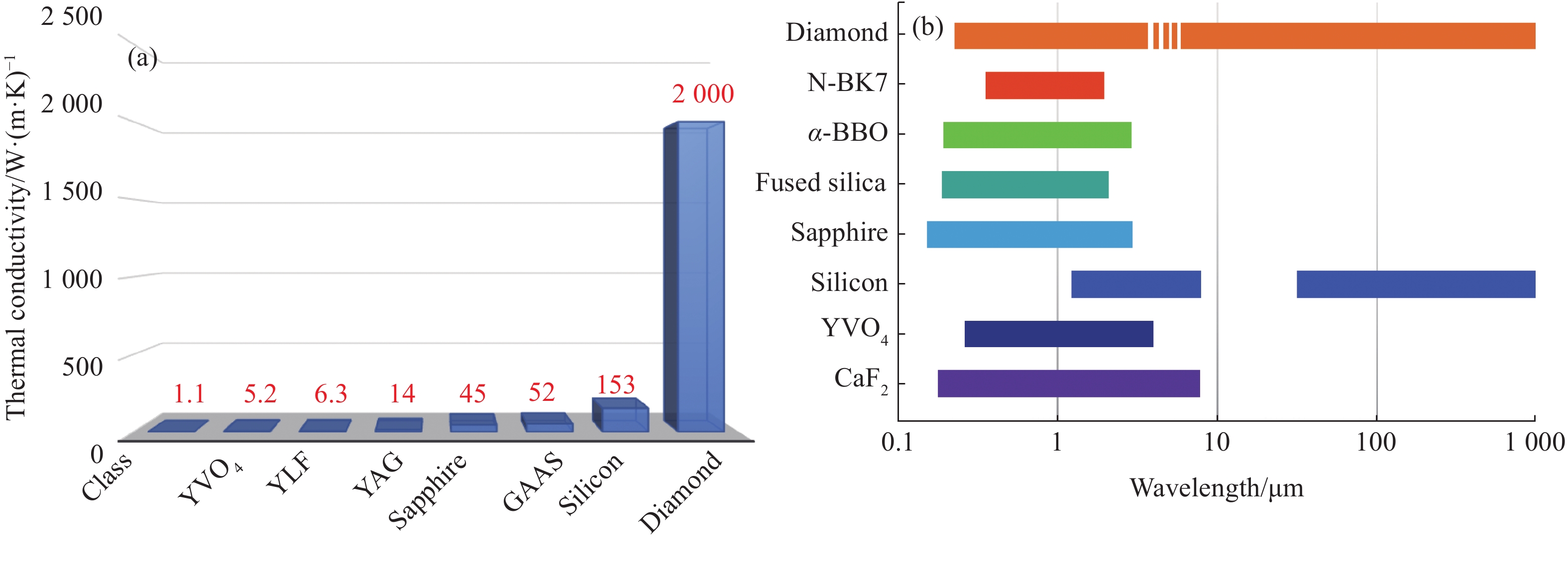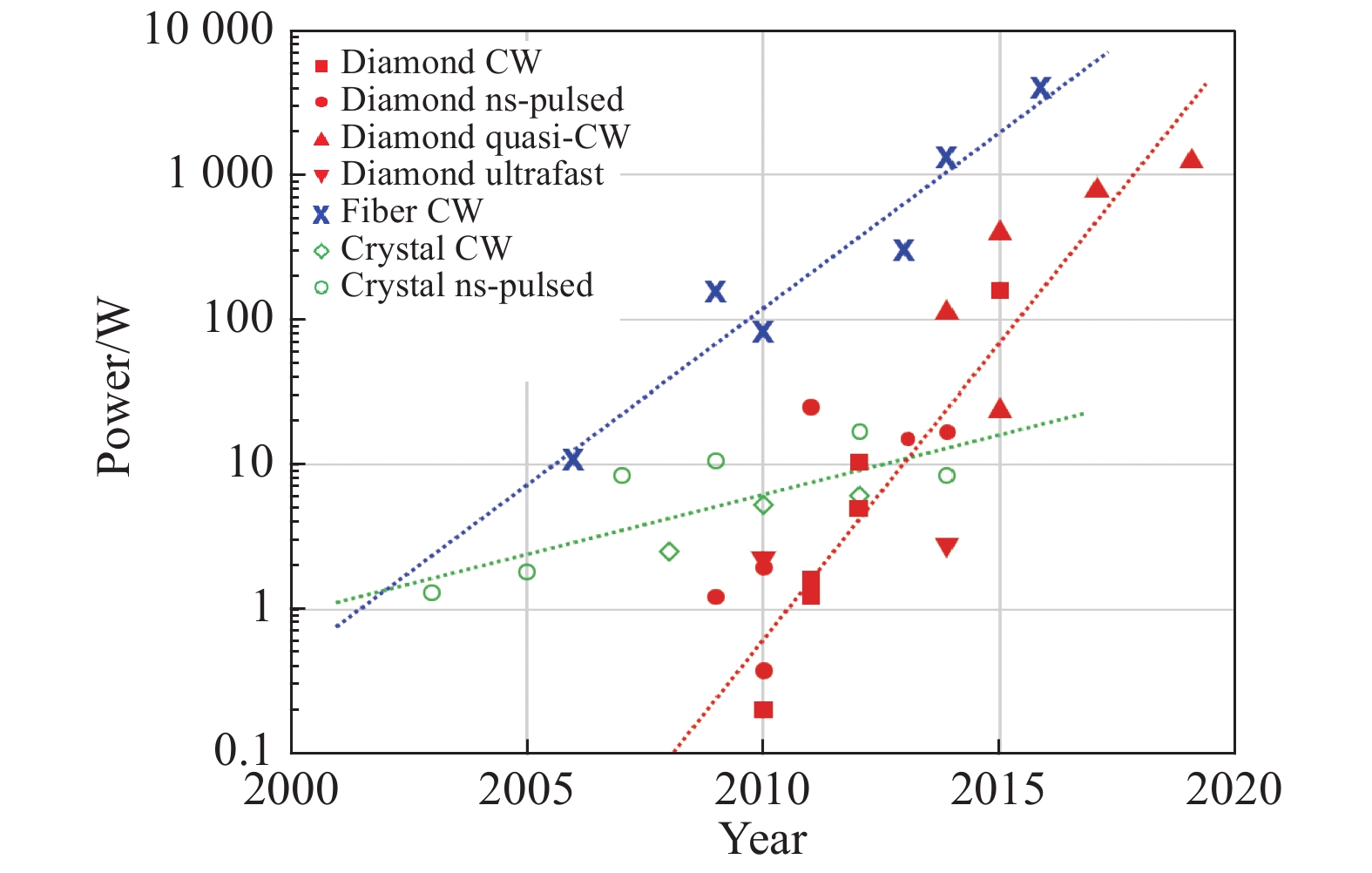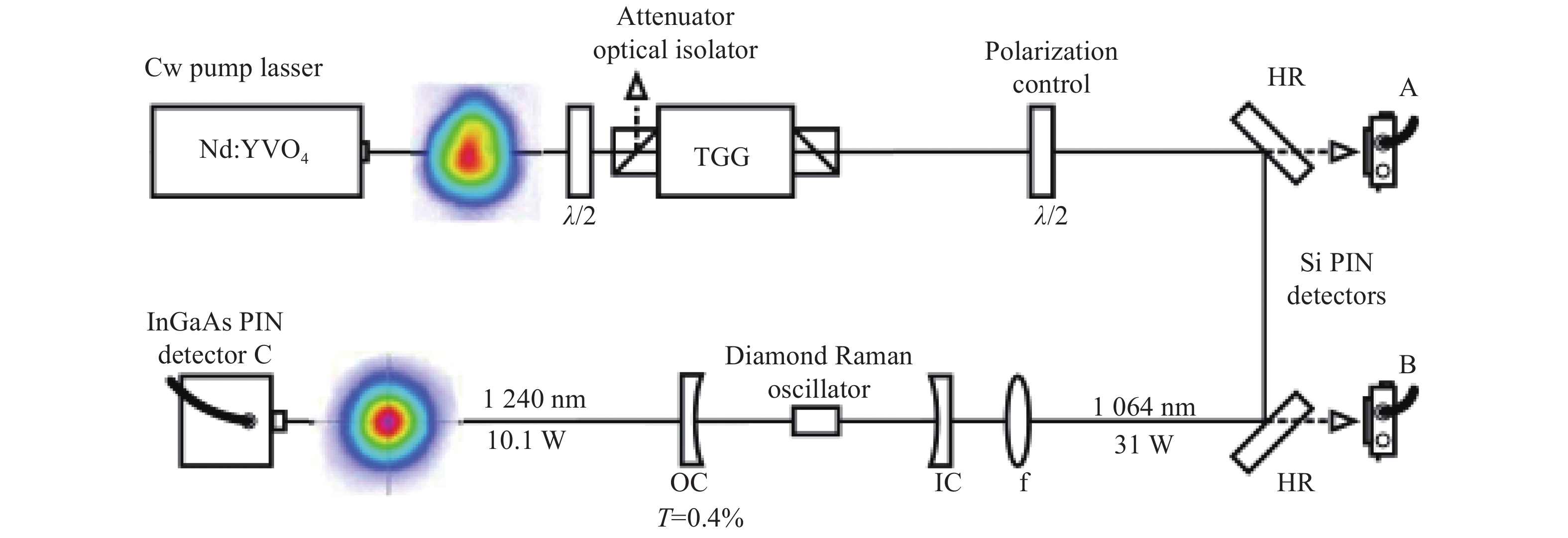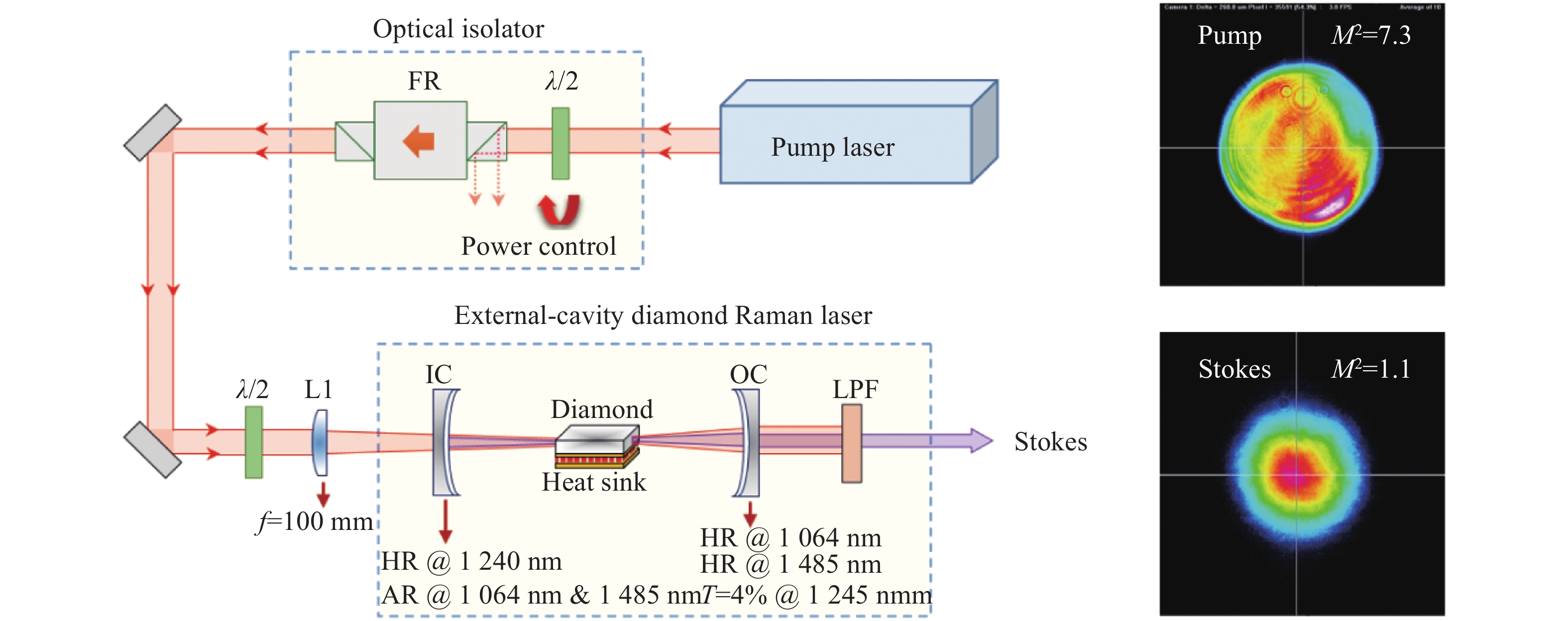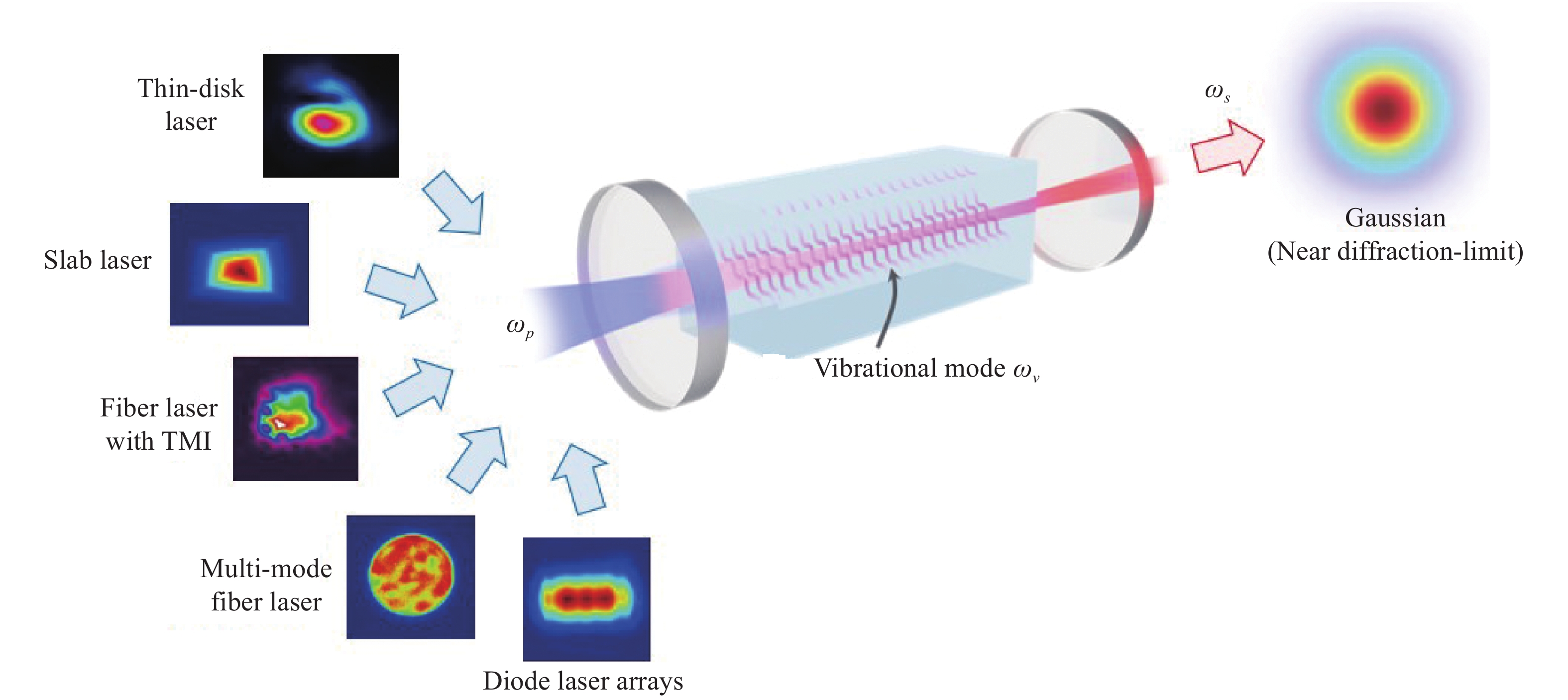HTML
-
具有高功率、高亮度的激光在国防、空间探测、遥感等领域有着重要的应用[1-5]。工作波长的拓展以及输出功率的提升是激光技术的两个重要发展方向,在传统粒子数反转激光器中,激光的输出波长是由工作物质的固有发射光谱决定的,因此有限的激活离子种类使得激光的工作波长受到一定的制约。另外,在激光功率提升的过程中,工作物质内部加剧积累的热效应将引发如热致双折射、热透镜等负面效应,导致输出激光的空间相干性(如空间分布、发散角等)恶化,甚至出现光束的亮度随功率的提升反而降低的现象[6-8]。图1展示了具有不同波长的高功率、高相干光源的典型应用及获取此类光源面对的挑战。
激光介质中有限的热负载能力是阻碍激光功率和亮度提升的核心问题,为了能够在增加激光输出功率的同时降低热效应等负面效应对激光亮度的影响,人们将激光工作物质制成板条[9-11]、光纤[12-14]、薄片[15-17]等结构以增加单位体积增益介质的表面积,并结合外部散热技术降低热效应的影响。其中,光纤激光器应用最为广泛,并已经实现了kW级的高功率单模激光输出[18]。然而,为了实现高功率激光输出,一方面需要增加工作物质的体积以提高系统的储能,这无疑增加了散热的难度;另一方面,工作物质表面积的增加将导致介质内部单位体积的光束模体积降低,引起非线性效应阈值降低,使输出激光的功率和光谱出现扰动。因此,找到具有高热负载能力的工作物质,是从“源头”解决激光功率提升中亮度退化的重要手段,但遗憾的是目前尚无一种激光工作物质能够满足人们的期望。于是人们探索将激光器产生的光束质量恶化无法抑制(或需要通过复杂设计、以牺牲转换效率等为代价才能抑制)的激光光束直接输出,然后通过非线性光学等手段将其转化成高质量的基模光束输出,以消除因功率提升以及工作物质固有的负面影响,人们将此方法称之为“光束净化”。
基于三阶非线性光学效应——受激拉曼散射(SRS)和受激布里渊散射(SBS)的激光器和放大器是实现光束净化的主要手段,其工作原理是:在受激散射和放大的过程中,泵浦光的相位和振幅畸变在介质的声子场中耗散,泵浦光中只有不包含空间畸变的能量才会被转移到Stokes场,由于Stokes光的空间增益是泵浦场和Stokes场的卷积,因此Stokes光经过多次放大后能够实现近衍射极限的高斯空间分布输出。目前,人们已经利用SRS和SBS效应,分别在波导(光纤)和空间结构中获得了有效的光束净化[19-23]。相比于SBS较小的频移,基于SRS的拉曼激光器和放大器在实现光束净化的同时还可以实现波长的转换,获得粒子数反转激光器无法直接获得的高亮度、特殊波长输出[24-25]。光纤拉曼激光器以其高转换效率等优点已被广泛用于产生高功率激光,并展现出色的亮度增强特性[26-31]。然而,随着泵浦功率的进一步增加,光纤中伴随而来的固有横模模式不稳定(TMI)现象[32]和在四波混频的作用下拉曼光纤激光器出现严重的光谱展宽效应[33],阻碍了其在亮度和输出功率方面的进一步提升。因此,探索非波导型结构的技术方法实现高功率、高亮度激光数输出具有重要的意义,而自由空间运转的拉曼激光器成为重要的突破口。为了获得高效率的自由空间拉曼激光运转并实现光束净化,需要一个具有高拉曼增益、高损伤阈值、高热导率等特性的材料作为拉曼增益介质。传统的晶体拉曼介质有YVO4[34-35]、Ba(NO3)2[36-37]等,但是受制于相对较低的热导率、热扩散系数等,这些晶体几乎无法实现高功率拉曼激光运转,其亮度增强效果并不明显。为了突破传统介质的瓶颈,具有极高热导率、高拉曼增益系数和宽光谱透过范围的金刚石晶体成为高功率拉曼激光器的新选择。研究成果表明,金刚石晶体在一阶和级联拉曼转换中成功实现了高功率和大尺度亮度增强。
文中介绍了金刚石拉曼激光器的发展现状,并对金刚石拉曼激光器在光束净化和亮度增强的研究进展进行了综述,并围绕其潜在的应用进行了探讨。
-
金刚石晶体以其优异的光学和热物性,已在非线性光学、热传导、光学窗口等领域成为目前炙手可热的晶体材料。图2为金刚石的热导率和透射光谱范围与其他常见晶体材料的对比[38-42]。从图中可以看出,金刚石的热导率远高于目前已知的晶体材料(是常用激光晶体YVO4的380多倍、YAG的140多倍);此外,相比于常见的拉曼晶体YVO4以及光学材料,金刚石的光谱透过范围更宽,在紫外、可见光、近红外及长波红外均具有极高的透过率。表1为金刚石与常见拉曼晶体的特性对比,可以看出金刚石晶体的拉曼增益和拉曼频移均高于其他拉曼晶体,其热导率也是其他常见拉曼晶体的几百倍甚至上千倍。基于以上的优良特性可知,相比于传统的晶体拉曼激光器而言,金刚石拉曼激光器可以承受更高的泵浦功率,可泵浦和发射的波长范围更广,且在相同的泵浦波长情况下只需要更少的阶次就可以达到期望波长[43-45]。除此之外,极高的热稳定性也使得金刚石能够在高温、高强度的严苛工作条件下呈现良好的性能。
-
早在1963年,研究人员就在天然金刚石中观察到拉曼散射现象[49],由于天然金刚石的光学质量无法满足作为拉曼增益介质的要求,因此金刚石拉曼激光器并未引起人们的足够关注。随着化学气相沉积法(CVD)等技术手段的成熟,现在人们已获得纯度比天然金刚石高几个数量级的高质量单晶金刚石,这也推动了人们对于金刚石激光器的研究逐渐深入[41, 50-51]。针对金刚石拉曼激光器的研究,主要体现在工作波长拓展、振荡器结构特性、运转模式(如:脉冲/连续、多纵模/单纵模)、输出功率提升等。
2004年,俄罗斯科学院的Kaminskii等人[52]分别利用0.5 μm和1 μm的纳秒和皮秒脉冲泵浦金刚石晶体,并成功测得了若干阶次的Stokes和反Stokes光谱。此后,人们通过金刚石拉曼转换实现了各种不同波长的激光输出,覆盖了紫外[53]、可见光[54-55]、近红外波段(含人眼安全)[48, 56-60]和中红外波段[61],运转方式也已经覆盖了纳秒至飞秒[52, 62-63],以及连续[58, 64]和准连续[1, 38]。基于金刚石晶体的优秀的热物性,金刚石拉曼激光器在高功率输出方面展现了巨大的优势[65]。2015年,Williams等人[43]利用功率为629 W的1 060 nm光纤激光器直接泵浦外腔金刚石拉曼激光器,获得了功率高达381 W的Stokes光输出。随后,Heinzig等[45]通过高功率单通泵浦的金刚石拉曼激光器,在泵浦光功率为970 W时获得了最大输出功率329 W、转换效率40%的拉曼转换输出。Antipov等人[44]利用光束质量恶化的泵浦光对金刚石拉曼激光器进行泵浦,得到稳态功率高达1.2 kW的激光输出。图3为近十几年不同运行方式的金刚石拉曼激光器输出功率与光纤和其他晶体拉曼激光器的对比。从图中可以看出,金刚石拉曼激光器的功率提升十分迅速,其最大输出功率比其他晶体拉曼激光器的功率要高两三个数量级。虽然目前金刚石拉曼激光器所获得的功率低于光纤拉曼激光器,但是得益于金刚石优异的光学性质和热物性,以及随着人造金刚石生长工艺及泵浦功率的提升,金刚石拉曼激光器的输出功率将具有很大的提升空间。
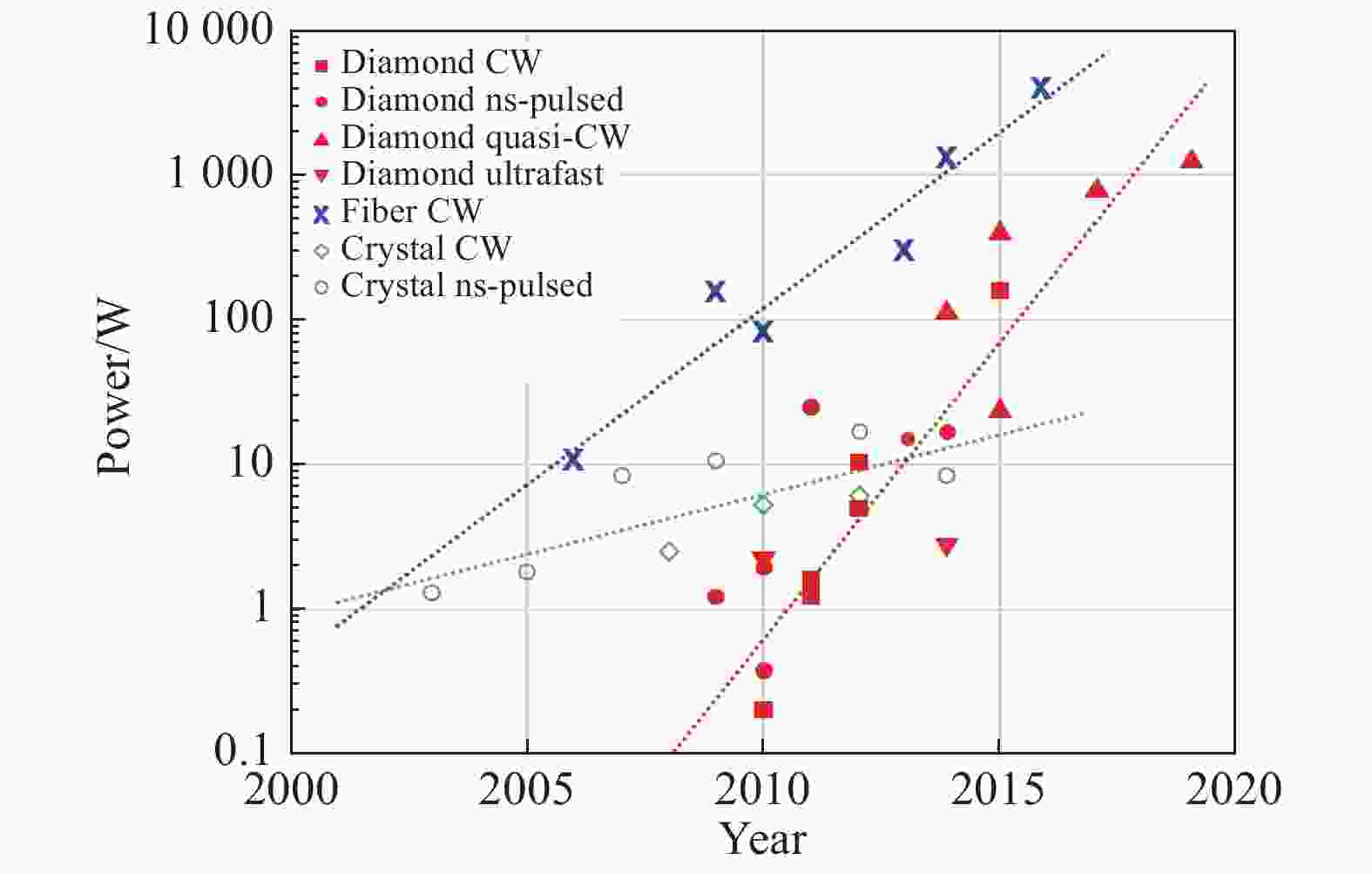
Figure 3. Comparison of output power between diamond Raman laser and other Raman lasers[65]
拉曼转换的自相位匹配特性使得拉曼光的空间和相位等特性并不受泵浦光光束特征的影响,在运行功率低于拉曼晶体热畸变阈值的情况下,输出拉曼激光的光束质量可相对于泵浦光得到提升,即产生光束净化现象。过去人们在基于LiIO3[66]、Ba(NO3)2[67]等晶体的拉曼激光器中已成功验证,但受到材料本身特性的限制,传统晶体拉曼激光器的光束净化仅在较低功率密度的情况下有效,这无疑限制了拉曼光束净化在人们广泛关注的高功率激光领域的应用。直至2012年,澳大利亚麦考瑞大学Kitzler等[21]通过对金刚石拉曼激光器高功率连续波转换的研究实验,在一阶金刚石拉曼转换中发现了光束净化效果,图4为实验装置图。输出拉曼激光的光束质量因子M2从泵浦源的1.7下降到一阶Stokes光的1.16 (近场光斑分布见插图),在输出Stokes光功率达到10.1 W时没有发现光损伤情况。随后人们对金刚石拉曼激光器的光束净化以及由此带来的亮度特性展开了研究。
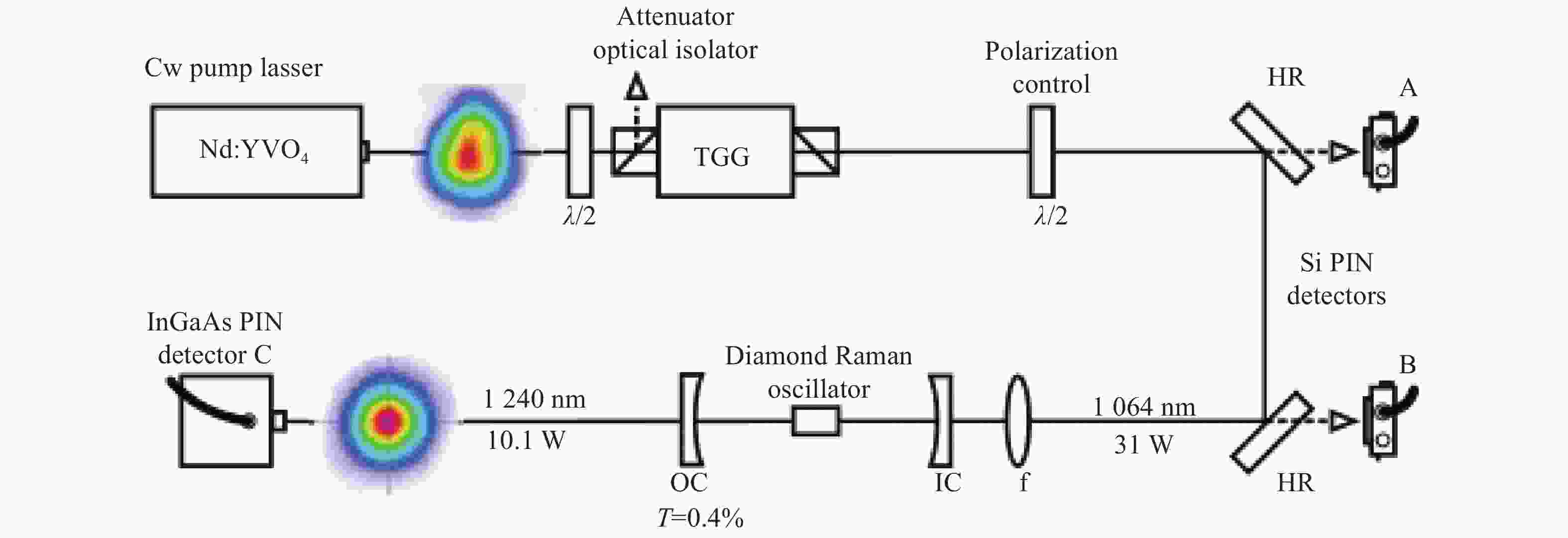
Figure 4. Schematic of external cavity diamond Raman laser[21]
-
在拉曼转换过程中,通常利用亮度增强因子(BEF)来表征Stokes光相对泵浦光的亮度的增强程度,由Stokes光和泵浦光亮度计算得来。其中,光束的亮度B定义为[68-69]:
式中:P为激光功率;λ为光束的波长;
$\mathop M\nolimits_x^2 $ 和$\mathop M\nolimits_y^2 $ 分别为光束在x和y方向上的质量因子;M2为总的光束质量因子(${M^2} = {\left( {M_x^2 \cdot M_y^2} \right)^{{1 / 2}}}$ )。从公式(1)可以看出,光亮度与光束功率成正比、与波长和光束质量因子的平方成反比。亮度增强因子BEF等于Stokes光亮度Bs与泵浦光亮度Bp的比,即:式中:
${\eta _{eff}} = {{{P_s}} / {{P_p}}}$ 为Stokes功率与泵浦功率的比值,即拉曼转换效率;λp和λs分别为泵浦光和Stokes光波长;$M_p^2$ 和$M_s^2$ 分别代表泵浦光和Stokes光的光束质量因子。根据公式(2)可以得到Stokes光相对于泵浦光的亮度变化,当BEF>1时,Stokes光的亮度高于泵浦光亮度,即实现了亮度增强,该公式对于级联拉曼激光器同样适用。 -
自Kitzler等[21]在连续波金刚石拉曼转换中观察到光束净化效果后,科研人员针对金刚石拉曼转换中的亮度特性展开了研究,在脉冲和连续泵浦情况下均实现了一阶和级联拉曼的亮度增强。
-
澳大利亚麦考瑞大学同一团队的Bai等[1]通过光束质量可调的激光作为泵浦源,对外腔金刚石拉曼激光器的一阶Stokes光的光束质量和亮度进行了研究。实验装置如图5所示,泵浦源为波长1 064 nm、光束质量因子M2在1.5~7.3范围内可调的准连续Nd:YAG激光器,泵浦光通过外腔金刚石拉曼激光器后在M2变化的全范围内均实现了近衍射极限的1 240 nm一阶 Stokes光输出(光束质量因子M2=1.10±0.03),且拉曼转换的斜效率(78%±3%)并未受到泵浦光光束质量的影响,在有限的泵浦功率下输出的最高Stokes光功率为390 W。图5的插图分别为泵浦光M2=7.3时的近场光斑分布及其对应的输出Stokes光的近场光斑分布。当泵浦光M2为7.3时,获得最高亮度增强因子BEF为12.7。结果可以看出,金刚石拉曼激光器在实现光束净化的同时,也能够有效将高功率、低光束质量泵浦光转换成高亮度的Stokes光。此外,笔者提出基于金刚石拉曼转换的亮度增强有望应用于高功率半导体激光阵列的光束整形,并通过理论计算得到光束质量因子M2为35的980 nm半导体泵浦光对相同结构的金刚石拉曼激光器进行泵浦时,其拉曼阈值功率约为430 W。与拉曼光纤激光器相比,采用金刚石晶体不但可以获得更宽的波长范围,还能够避免光纤中存在的横模模式不稳定等负面问题。
2019年,Antipov等[44]将泵浦功率提升至kW量级,进一步开展一阶金刚石拉曼亮度增强的实验研究,实验装置及结果如图6所示。利用M2为15的空间分布严重恶化的1 064 nm激光作为泵浦源,通过一阶金刚石拉曼转换,最终在1 240 nm处得到稳态功率1.2 kW、光束质量因子M2=1.25的高光束质量激光输出,其亮度增强因子高达56。
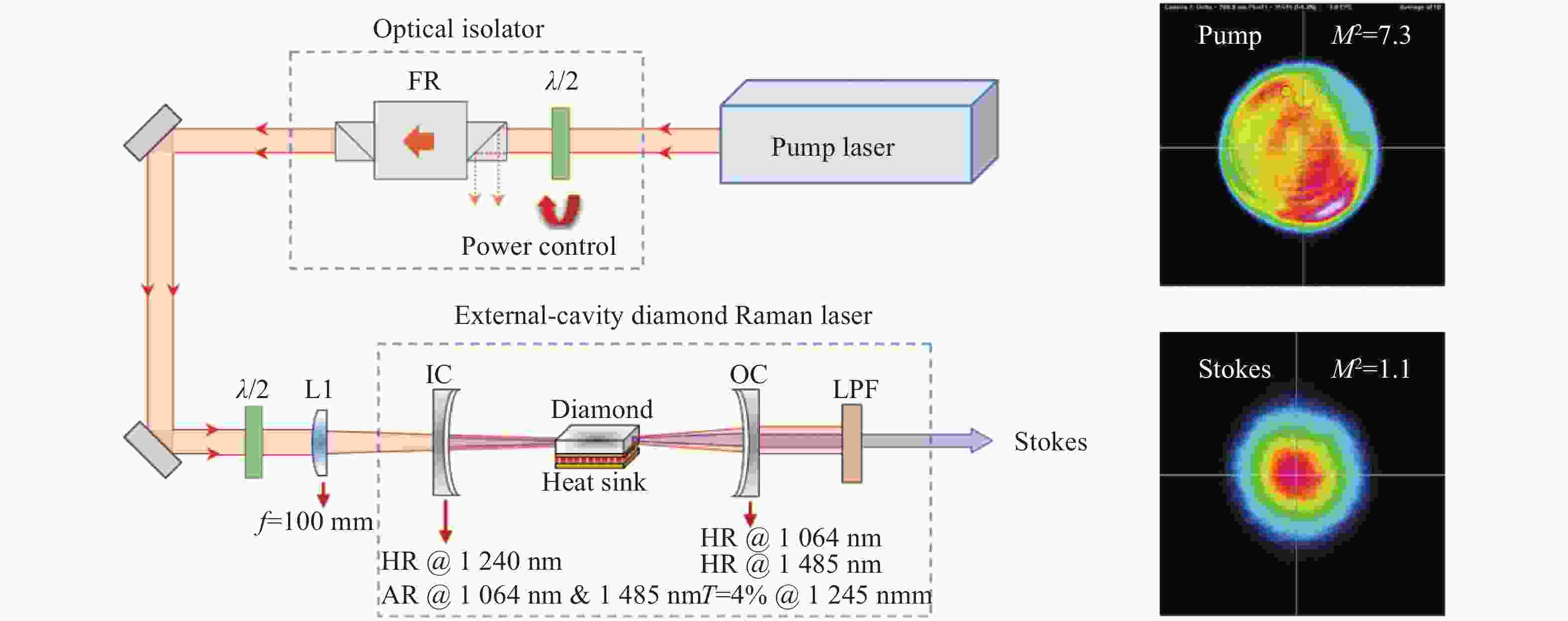
Figure 5. External cavity diamond Raman laser and its near-field spot distribution of pump and Stokes beam[1]

Figure 6. Experimental device and results of kW-level external cavity diamond Raman laser[44]
-
金刚石具有目前已知拉曼晶体材料中最大的拉曼频移(1 332 cm−1)[39, 70],也使得金刚石拉曼激光器在实现特殊波长转换时具有更大的优势。因此,在一阶金刚石拉曼转换亮度增强的研究基础上,开展级联金刚石拉曼激光器的亮度增强研究同样具有重要的意义。McKay等[68]利用M2=3~4的1 064 nm纳秒脉冲激光泵浦金刚石拉曼激光器,通过二阶金刚石拉曼转换,在1 485 nm人眼安全波段得到了M2为1.17的Stokes激光输出。测得的泵浦光和拉曼光亮度随入射泵浦功率的变化以及相对应的近场光斑对比如图7所示,最终获得的最高二阶拉曼转换的亮度增强因子为1.7。
2018年,Bai等人[71]利用准连续光源开展级联金刚石拉曼激光器的亮度增强研究。图8为采用的外腔金刚石拉曼激光器结构及对应的泵浦光和拉曼光的近场光斑分布。为了获得高效的拉曼转换,输入镜IC表面镀有泵浦光(1 064 nm)增透膜以及一阶Stokes光(1 240 nm)和二阶Stokes光(1 485 nm)的高反射膜;输出镜OC表面镀有1 064 nm和1 240 nm的高反射膜,以及1 485 nm的部分反射膜(实验为T=55%)。当泵浦光M2=6.4、功率为832 W时,得到最高功率为302 W的1.49 μm二阶Stokes光输出,对应光束质量因子M2为1.1。通过对比泵浦光与输出二阶Stokes光近场光斑分布图可以看出,即使在泵浦光出现严重高阶模以及散光现象的情况下,二阶Stokes光仍可达到近衍射极限的高斯分布输出。此外,笔者基于理论计算得出通过优化腔型设计进一步降低阈值功率、提高转换效率及亮度增强因子的方法。

Figure 7. Change of pump and Raman laser brightness with pump power(insert shows the near-field spot of pump beam and Stokes beam)[68]

Figure 8. Cascaded external cavity diamond Raman laser and its corresponding near-field spot distribution of pump and Stokes beam[71]
-
基于金刚石的高拉曼增益系数、较大的拉曼频移、宽光谱透过范围以及极好的热物性,研究人员在金刚石拉曼激光器的亮度增强、输出功率以及转换效率等方面做了大量的工作。其中,在一阶金刚石拉曼转换中实现了稳态功率kW级的近衍射极限输出,且亮度达到泵浦光的50余倍。此外,通过二阶级联金刚石拉曼转换,在应用更加广泛的人眼安全波段也实现了高效率的拉曼转换,并得到了稳态功率300 W以上、亮度增强因子高达6.0的近衍射极限二阶拉曼激光输出。以上结果为实现高效率的拉曼激光转换获得特定波长输出奠定了基础,同时为超高功率的激光光束净化提供了新的技术路径。如图9所示,金刚石拉曼激光器有望将如多模光纤、半导体、板条等直接输出的kW量级的高功率、但光束具有明显畸变的激光转换成高质量激光输出。
虽然金刚石具有很高的热导率,但是受限于光学级人造金刚石有限的尺寸(~1 cm),人们通常需要将泵浦光进行聚焦,因此导致金刚石晶体中心的功率密度较高,近期人们也在高功率运转的金刚石拉曼激光器中观察到金刚石晶体微弱的热效应[44, 72]。因此,未来进一步研究金刚石的热量转化和传递过程,对实现更高功率、更高转换效率和更强亮度的金刚石拉曼激光输出具有重要的意义。此外,由于拉曼转换过程不会受到空间烧孔效应的影响,通过金刚石晶体的拉曼转换,成功实现了单纵模激光运转[73-77]。这些研究结果为以后实现单纵模亮度增强级联金刚石拉曼激光输出提供了理论支撑,有望进一步拓展高亮度金刚石拉曼激光器的应用。



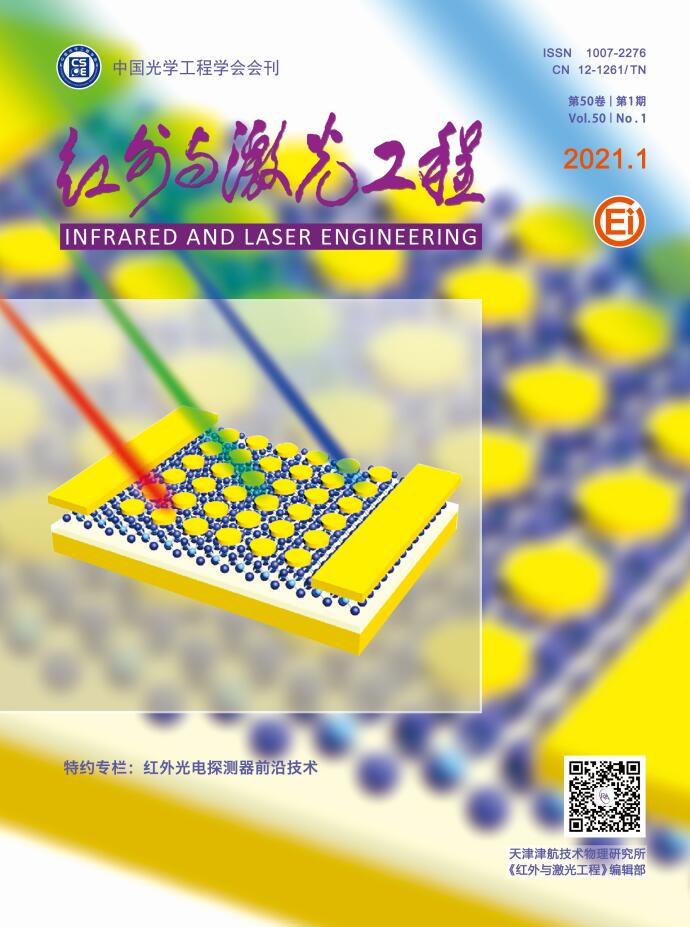


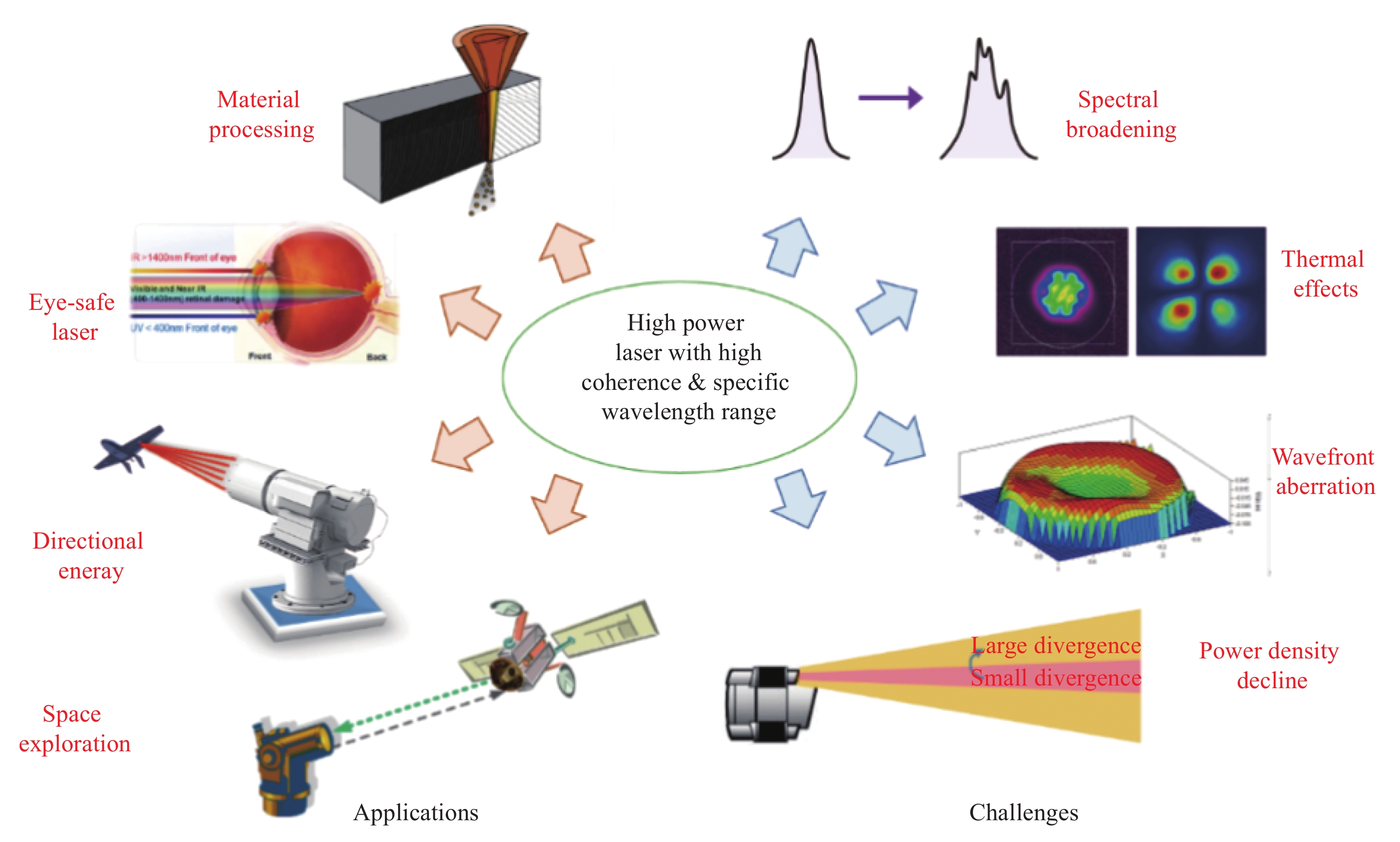












 DownLoad:
DownLoad:
